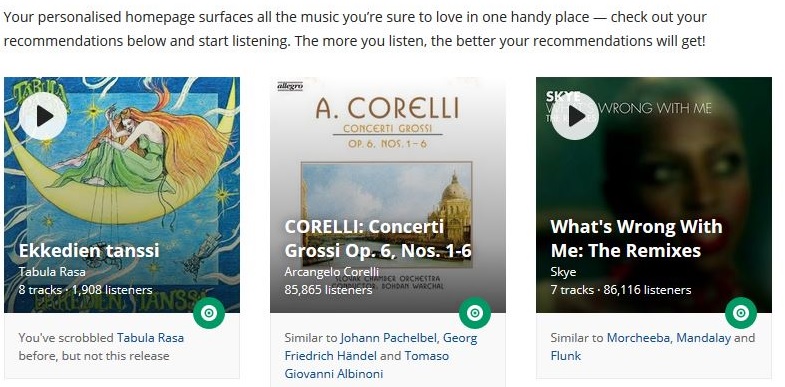Last.fm is a music website, founded in the United Kingdom in 2002. Using a music recommender system called "Audioscrobbler", Last.fm builds a detailed profile of each user's musical taste by recording details of the tracks the user listens to, either from Internet radio stations, or the user's computer or many porLast.fm offers customised virtual "radio stations" consisting of uninterrupted audio streams of individual tracks selected from the music files in the music library.

Stations can be based on the user's personal profile, the user's "musical neighbours", or the user's "friends". Tags also have radio stations if enough music has the same tag. Radio stations can also be created on the fly, and each artist page allows selection of a "similar artists" or "artist fan" radio station. As of May 2009, Last.fm introduced Visual Radio, an improved version of last.fm radio. This brought features such as an artist slideshow and combo stations, which allows for listening to stations consisting of common similar artists of up to either 3 artists or 3 tags.[59]
Under the terms of the station's "radio" license, listeners may not select specific tracks (except as previews), or choose the order in which they are played, although any of the tracks played may be skipped or banned completely. The appropriate royalties are paid to the copyright holders of all streamed audio tracks according to the law in the UK. The radio stream uses an MP3 stream encoded at 128 kbit/s 44.1 kHz, which may be played using the in-page flash player or the downloaded Last.fm client, but other community-supported players are available as well as a proxy which allows using a media player of choice.table music devices. This information is transferred ("scrobbled") to Last.fm's database either via the music player itself (including, among others Spotify, Deezer, Tidal, and MusicBee) or via a plug-in installed into the user's music player. The data is then displayed on the user's profile page and compiled to create reference pages for individual artists. On 30 May 2007, it was acquired by CBS Interactive for UK£140 million (US$280 million)
History
Last.fm was founded in 2002 by Felix Miller, Martin Stiksel, Michael Breidenbruecker and Thomas Willomitzer, all of them from Germany or Austria, as an internet radio station and music community site, using similar music profiles to generate dynamic playlists. The site name takes advantage of a domain hack using .fm, the top level domain of Micronesia, popular with FM radio related sites. The "love" and "ban" buttons allowed users to gradually customise their profiles. Last.fm won the Europrix 2002 and was nominated for the Prix Ars Electronica in 2003. The Audioscrobbler and Last.fm teams began to work closely together, both teams moving into the same offices in Whitechapel, London, and by 2003 Last.fm was fully integrated with Audioscrobbler profiles. Input could come through an Audioscrobbler plugin or a Last.fm station. The sites also shared many community forums, although a few were unique to each site. The old Audioscrobbler site at the audioscrobbler.com domain name was wholly merged into the new Last.fm site on 9 August 2005. Audioscrobbler.net was launched as a separate development-oriented site on 5 September 2005. However, at the very bottom of each of the Last.fm pages there was an Audioscrobbler "slogan", which changes each time the page is refreshed. Based on well-known sayings or advertisements, these originally appeared at the top of the Audioscrobbler website pages and were all created and contributed by the original site members
Radio stations
Last.fm offers customised virtual "radio stations" consisting of uninterrupted audio streams of individual tracks selected from the music files in the music library.
Stations can be based on the user's personal profile, the user's "musical neighbours", or the user's "friends". Tags also have radio stations if enough music has the same tag. Radio stations can also be created on the fly, and each artist page allows selection of a "similar artists" or "artist fan" radio station. As of May 2009, Last.fm introduced Visual Radio, an improved version of last.fm radio. This brought features such as an artist slideshow and combo stations, which allows for listening to stations consisting of common similar artists of up to either 3 artists or 3 tags.[59]
Under the terms of the station's "radio" license, listeners may not select specific tracks (except as previews), or choose the order in which they are played, although any of the tracks played may be skipped or banned completely. The appropriate royalties are paid to the copyright holders of all streamed audio tracks according to the law in the UK. The radio stream uses an MP3 stream encoded at 128 kbit/s 44.1 kHz, which may be played using the in-page flash player or the downloaded Last.fm client, but other community-supported players are available as well as a proxy which allows using a media player of choice.

More details about history and development of the company you can find on Wikipedia